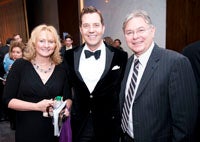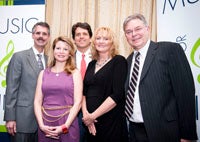Music for the Mind Supports New Science

Posted in GUMC Stories
 Mark and Jeanne Shriver told their children that they were going to speak at a party and concert at the Kennedy Center to raise money to help people suffering from brain diseases like the Alzheimer’s that killed their grandfather, Sergeant Shriver, American statesman and activist.
Mark and Jeanne Shriver told their children that they were going to speak at a party and concert at the Kennedy Center to raise money to help people suffering from brain diseases like the Alzheimer’s that killed their grandfather, Sergeant Shriver, American statesman and activist.
“What would you say to these people?” Mark Shriver asked his children.
“Hold on!” 14-year old Molly blurted out as she ran to her room. Racing back, she handed her father a piece of paper he recognized as one his mother Eunice Kennedy Shriver had carried with her for years. It quoted British Prime Minister Winston Churchill telling school children during World War II: “Never, ever, ever, ever, ever, ever, ever, give up.”
Shriver shared Molly’s message of persistence with the 200 people who attended the second annual “Music for the Mind,” a March 31 fundraising event to support Georgetown’s young scientific investigators advance their research on treatments and cures for neurological diseases and disorders at Georgetown University Medical Center (GUMC). The Shrivers are honorary co-chairs of the event, and William and Dana Schreiner serve as co-chairs.
A mood of hope and a measure of good-hearted urgency permeated the elegant evening and the unmistakable unity of a supportive philanthropic community to battle Alzheimer’s, Parkinson’s, stroke and traumatic brain injury, among other diseases and disorders.
 “I am so grateful for the generosity of this community, and the opportunities it affords to young investigators like myself to pursue research that will help in furthering our understanding of these tragic neurological illnesses,” said Sally L. Long, Ph.D., assistant professor of neurology and member of the Memory Disorders Program at GUMC, where she examines patterns of cognitive dysfunction in clinical trial participants.
“I am so grateful for the generosity of this community, and the opportunities it affords to young investigators like myself to pursue research that will help in furthering our understanding of these tragic neurological illnesses,” said Sally L. Long, Ph.D., assistant professor of neurology and member of the Memory Disorders Program at GUMC, where she examines patterns of cognitive dysfunction in clinical trial participants.
A neuropsychologist, Long is developing a research program to investigate cognitive resilience in neurologic illness and aging. “I am honored to have been a part of Music for the Mind.”
Alessia Bachis, Ph.D., an assistant professor of neuroscience, is developing chemical compounds that can be formulated into drugs to prevent or treat degenerative brain diseases, focusing especially on dementia caused by HIV. “Early-career support is so meaningful for all of us working to fight these insidious diseases,” she said. “Thank you to all those who contributed.”
Long and Bachis are among several young Georgetown scientists currently being considered as finalists for Georgetown’s 2012 Neuroscience Young Investigators Award. Last year two young investigators each received $25,000 awards:
- Hyang-Sook Hoe, Ph.D., is using her award to study using histone deacetylase (HDAC) inhibitors as an agent to treat Alzheimer’s disease.
- Charbel Moussa, M.B.B.S., Ph.D., is testing on laboratory models his gene theory strategy that could potentially restart memory formation for patients with dementia. His Young Investigator Award already has led to advances in the technology and to an industry collaboration that will galvanize his quest for treatment for dementia.
Now, more than ever, conquering these intricate, seemingly impenetrable brain diseases requires vigorous progress and philanthropic nourishing of brilliant young scientists that can propel research to a deeper level and speed access to therapies and cures, said Howard J. Federoff, M.D., Ph.D., executive vice president for health sciences and executive dean of the school of medicine.
Georgetown University Medical Center has deep strength in treating these diseases and breaking-ground for cures and treatments. GUMC has received U.S. Food and Drug Administration approval of the first-ever gene therapy clinical trial for Parkinson’s, one of the largest ever clinical trials in Alzheimer’s, the first ever gene therapy trial for patients with Alzheimer’s-induced dementia, and one of the nation’s most innovative stroke education programs.
Federoff, whose own research focuses on Parkinson’s disease, said that neurologic diseases of all kinds are on the rise and that we are “just at the beginning of what will be a scourge that will likely be unparalleled in modern history — it is a demographic that all of us are confronting, what some call the Silver Tsunami.”
About 10,000 thousand inpiduals turn 65 years of age every day. This so-called Silver Tsunami is expected to triple the number of people with Alzheimer’s from the current count of 35 million to nearly 115 million in the next 30 years. The numbers of other neurodegenerative diseases are also on the rise with the aging population. Parkinson’s disease is expected to double by 2030, and traumatic brain injuries are sustained by 1.7 million Americans each year.
Event co-chair Bill Schreiner’s father was George Schreiner, M.D., a legendary Georgetown nephrologist, who broke new ground in treating patients with alcohol and chemical poisoning through life-saving dialysis and was the first doctor ever to administer dialysis to an infant.
Bill spoke movingly of witnessing the ravaging effects of late stage Alzheimer’s on his father, including how the disease took away his personality before it ultimately took his life.
“Therein lies the real, extreme cruelty of Alzheimer’s – it takes people right out of their lives and takes the life right out of them just at a time when they should be looking back over their lives and enjoying their families,” Schreiner said.
Our greatest hope for treatments and cures, Federoff said, is funding to support and harness the brilliance and fresh outlook of young scientific minds of investigators such as Long, Bachis, Moussa, and Hoe, who are brimming with new ideas and approaches.
“They’ll change the face of these diseases,” Federoff told the crowd to applause.
The event’s guests were uplifted in the hope that working together to support cutting-edge research, fostering young investigators, and “never, ever giving up”, can create a legacy that will allow children like Molly Shriver more quality time with beloved grandparents.
By Victoria Churchville, GUMC Science Writer
(Published April 11, 2012)
